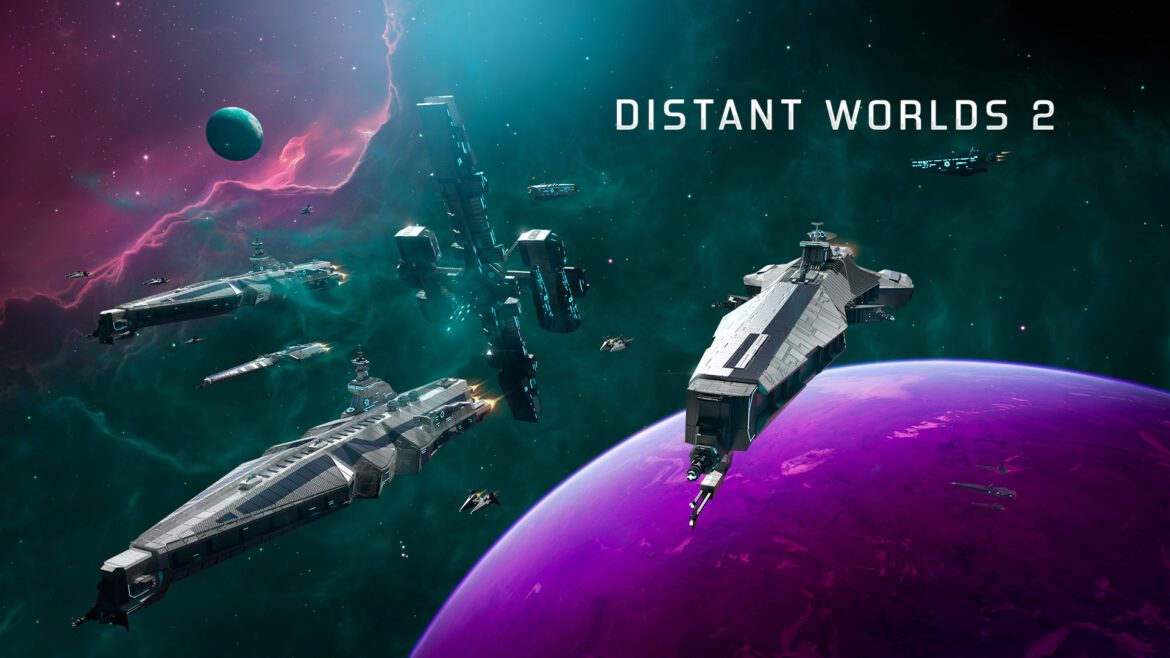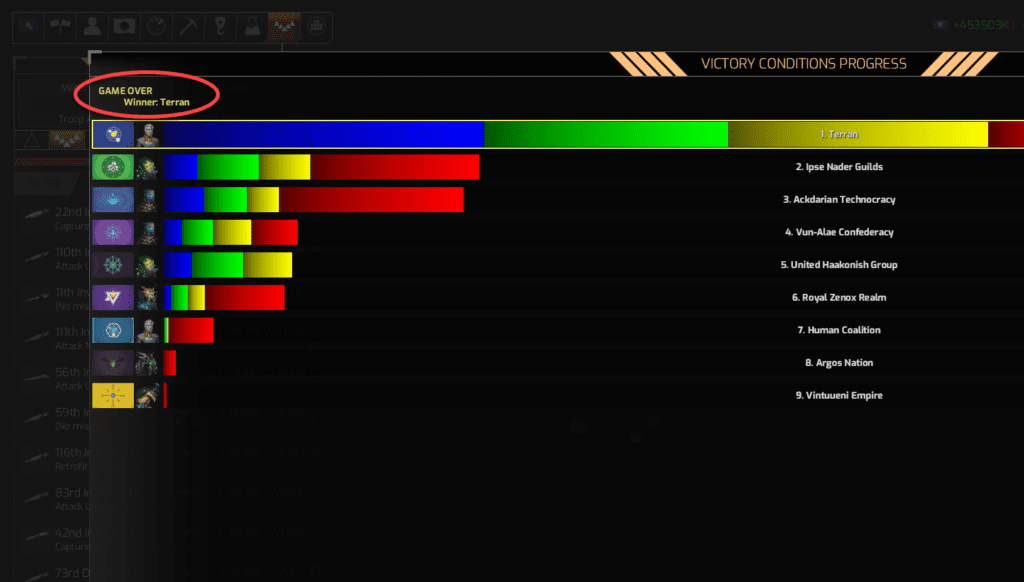Distant Worlds 2 was developed by CodeForce and published by Slitherine, who were kind enough to provide me with a review code. I must say that I happily jumped at the opportunity to test it, since I had the prior titles in fond memory, the last one being Distant Worlds: Universe, which still sits at “Mostly Positive” rating on Steam with some 75% of players finding it positive. After all, 4x strategy is an acquired taste.
Distant Worlds 2, the long awaited sequel in the series (Universe was published in 2014) currently has a “mixed” rating on Steam, with 67% of users rating the game positively. After having spent around 80 hours in the game and finishing a campaign as a human empire, I must admit that I have mixed feelings about the game myself.
On the Grandy Strategy scale of things…
Distant Worlds 2 is a 4x space strategy game that puts you in charge of your own galactic empire. Let us start of with positive things, since my opinion of the game, overall, is actually quite positive. One of its major strengths lies in the fact that you can go as deep into the details as you prefer, and decide how many aspects of the game you wish to control. Players can customize the amount of automatization to an extreme extent, ranging from having direct control over even the smallest detail such as ship design and taxes for each colony to delegating almost everything to the point where the game essentially plays itself. Those who prefer to focus on the conquest of the galaxy can simply delegate other parts of administration such as economy, taxes and colonization to the AI and focus exclusively on fleet actions and waging interstellar wars. Those who prefer micromanagement will be in heaven.
The galaxy, even on the default setting, is large, perhaps even too large. It will take you a long time to conquer it, but that is only partially due to its size; the other part is the dynamic of the game. On the default settings it seems much slower than other titles from this genre, so that it scales properly. A single major space battle that results in the loss of your largest fleet will not be the cause of your doom. When it comes to the conquest and expansion at the expense of your galactic neighbors, the game is focused much more on the strategic level than the tactical battles, and your industry – if strong enough – can kick back into gear and provide you with new fleets that can counter the imminent threat rather efficiently.
But I am getting ahead of myself, I guess. Let us wind back and focus on the very start of the game.
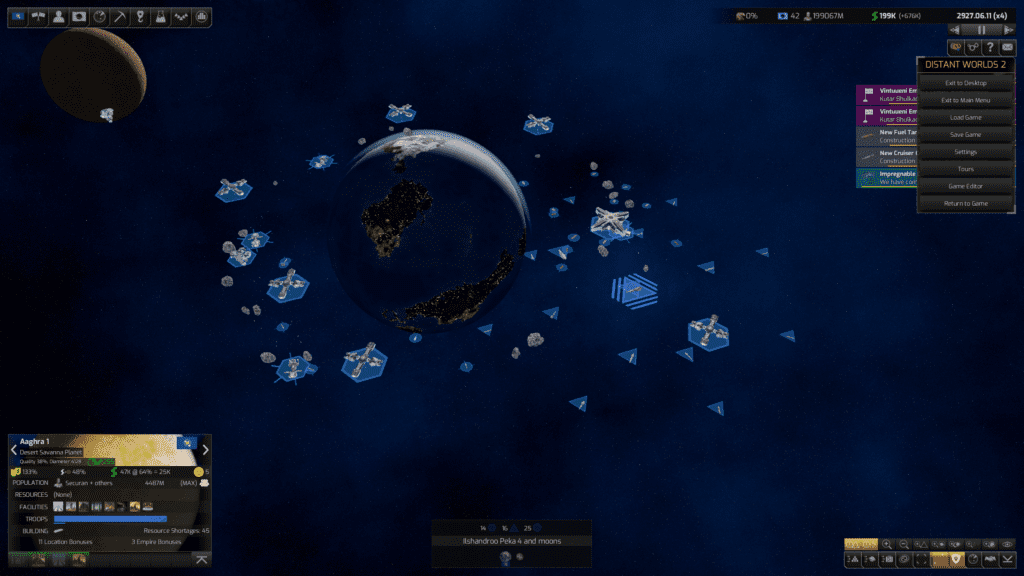
Planets are hubs for spaceports, mining and research bases, as well as resorts for tourists
4X: Time to eXplore
The default setting will put you in the position of your species’ first steps into the Great Unknown, where you build your first ships and start to tackle the research to develop the initial, crude hyper-speed drive. You build your exploration ships, send them throughout your system and, eventually, towards the neighboring stars, receiving updates as they discover new resources and places of interest. One noteworthy thing is the fact that the ships initially will not be able to scan and discover everything on planets, for example, and you will have to research better sensors and exploration devices, so that the exploration in this game lasts much longer than in other comparable titles. Once you have found a resource that you find interesting, you can send a construction ship to build a mining base in the orbit of the celestial body in question. Soon, these bulky construction ships will be racing across your territory to finish up all the tasks set for them, and you will need to make sure you have an optimal number of them at any given time.
This is where you will encounter your first problem; the space pirates. However, and here is one of the first issues of the game, the space pirates are not dangerous as long as you pay them their protection money. It is by default a fairly small sum, and even at the start it is much more easy to simply pay them off rather than to build ships and fight them in the early game. The best course of action is to pay them off, build up your strength and eventually simply eradicate them once you are strong enough. You can even trade with them at times, getting navigational and exploration info on some systems you did not visit yet or learning a location of an independent colony.
First contact: What to do with independent colonies?
At the very early game you will encounter independent colonies, which are merely single worlds inhabited by a particular species. They do not expand and do not colonize any further beyond their homeworld, and they may or may not be the same species as you are. You can choose how to deal with them, but anything from an outright attack and conquest, perhaps even extermination (after all, this is a 4X game!) to use of diplomacy to peacefully integrate them into your empire. I found the easiest way to handle this is to pay them money aka send gifts until they have had sufficient trust and “positive feels” towards my empire to first propose a limited trade agreement and eventually invite us to colonize their planet, thus integrating them into our empire. It seems a bit too easy, truth be told, even at the very start when the money is scarce, but it is way more tedious to take that route than to build a fleet and a landing army to conquer them. This takes time, money and a lot of precious resource, which brings me to the next and one of my favorite parts of the game – resources.
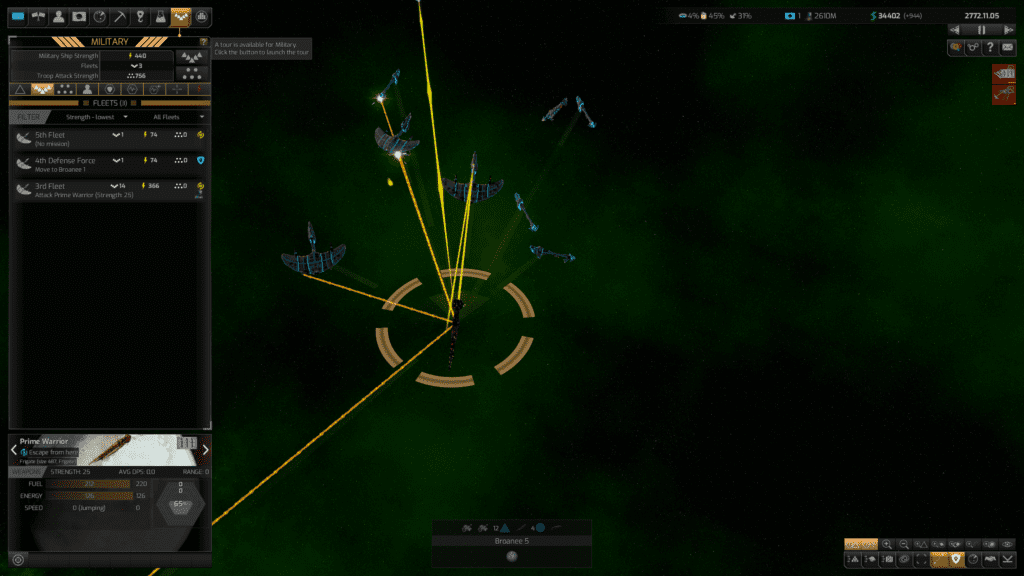
Fleet fights are mostly hands off, but you can take over the control on tactical level and set targets for your controlled ships
“My Precious”: Resources
One thing I have immensely enjoyed in Distant Worlds 2 is the nature of resources. Unlike other games, where the gathered resources enter a “magical reservoir” that can be tapped at any point in the galaxy, the resources here are a physically (well, so to speak) defined unit. There is a metric ton of resources, and all of them need to be mined, gathered in cargo holds of stations, transferred to ships and moved over to the place where they are required for a certain project. Ships require fuel, so they need to make sure they either have large enough tanks, that the stations they are at has enough in reserve or that you have fuel tankers that can follow and resupply your fleets. Want to starve your enemy to death? Block their supply routes. Make sure that your freighters, which are part of the private economy of your galactic empire (in other words, they are built in private sector, you can’t directly control them and they move pretty much everything across the galaxy) are equally safe from the enemies, especially pirates which can be a nuisance in the early game. Work to establish resupply bases on your important economic and military routes.
Be aware! You should not blindly build mining bases everywhere there is a resource, that is a certain way to bankrupt your empire. Check how much of the specific resource you have, see what the prices for it are, and how much a maintenance of a mining base there will cost you, and only then make a decision. Building dozens of mining bases that mine a resource you have already stockpiled in excess is not worth it, since all these bases cost money to maintain, and the costs easily pile up across the galaxy.
eXpand the Empire
Colonizing other worlds is neither easy nor cheap. First, you will have to find anything near suitable to your species, and the chances are that you will have to research colonization of specific planet types to increase your survival chances. You can set the threshold for suitability for your colonies, and even lower it extensively, but that will garner you a heap of problems up to the time when you become technologically and financially able to terraform those worlds. Also, be advised that the colonies at the very start cost far more money then they bring it in, since your tax revenue comes from the population. Yet another thing I enjoyed is that there is no tedious planet tile management, and you are not limited to building five bloody buildings on a smaller planet. As long as you got money to maintain them, you can build as many as you have access to, though about half of them are focused on planetary defenses and the other one can be built only once per empire.
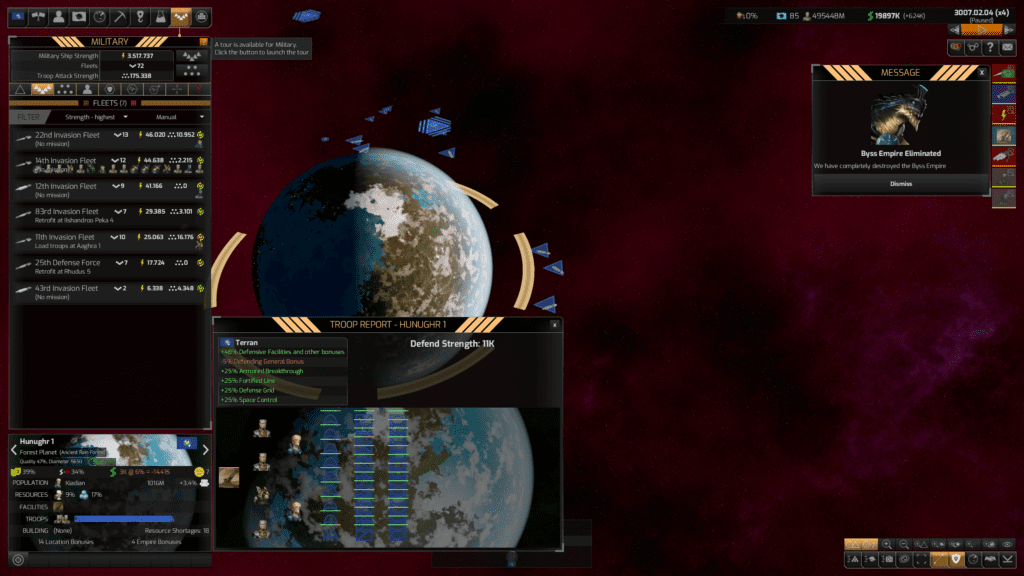
It is recommended to attack planets with overwhelming troop numbers, or else it will take a long time to get reinforcements there
Yet another positive thing about Distant Worlds 2 is the fact that there are no “space lines”, no galactic highways you must travel on. If your ship has enough fuel, it will fly to the start system in question. If not, it will go follow a route where it can refuel. However, when colonizing other planets you may be limited to a certain distance from your nearest planet, so pay attention to that setting at the very game start. At times, I found myself stuck in corner of a galaxy and unable to build a colony farther away, beyond enemy territory, because the desired planet or an independent colony that wanted to join was too far away.
eXploiting the galaxy, one planet at the time
We already spoke about the resources, a system that has been built up quite interestingly, so let us turn to the economy now. This is a tricky subject. In my experience, you will either fail miserably or generate millions of surplus. In my initial playthrough, the income and maintenance costs seemed utterly unbalanced. Despite my best attempts to be a good steward I was skimming the edge of bankruptcy more often than not, a position obviously shared with a large number of fellow players. This makes it extremely hard to run more than three fleets at a time, since the maintenance is a huge drag on your economy. Other than that corruption gobbles up a massive portion of you income, even when you are playing with species that should not be performing so abysmally bad in this aspect. Economy also does not have sufficient upgrades when it comes to research, and the unique buildings with empire wide bonus are both expensive to build and expensive to maintain.
However, at a later playthrough, I was paying much more attention to the investments into mining bases and various buildings that incur tremendous maintenance costs. I’ve put an embargo over the troop recruitment and had not a single soldier until they were absolutely necessary. This helped me to build a very solid foundation upon which the economy of my empire could thrive. In this playthrough, I would fare much better and have serious “federal reserves” to fall back upon.
eXtermination: How to be a proper Xenophobe
Pirates that you initially meet can be either a one-time thing or can “resurrect” and reappear on galactic map here and there, depending on what you chose in your starting options. I prefer them out of the game, once they died, since they eventually become just an insignificant nuisance. But there are also some other enemies, lurking in the vast emptiness of the space.
In one of my playthroughs I had an alien “Immortal swarm” carrier appearing out of nowhere and harassing my territory for the larger portion of the game. The damn thing was a a carrier class ship of some 25K fleet strength whereas I was still fielding frigates and destroyers in fleets barely reaching 700-800 offensive strength. The carrier would swoop in, destroy everything around a colony I owned, retreat back to a distant planet or other system, only to inevitably return to the point where it repeated the entire process. It seriously and irrevocably crippled the development of my empire, and I had to painstakingly amass a sufficiently large over decades of game time to kill it off. By then, my chances to rule the galaxy were virtually reduced to zero, and I had to launch another campaign.
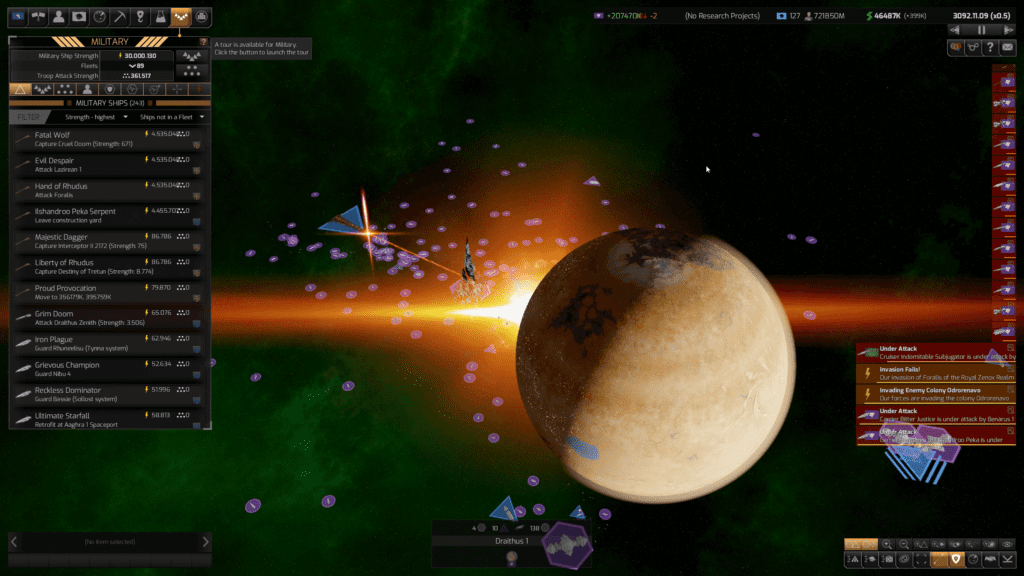
Distant Worlds 2 world destroyer in action. Oops, I just wanted to bombard them a bit…
Once the galaxy has been sufficiently populated, it is time to conquer. This part isn’t easy, and it is also one that the AI advisors fail at miserably. The main problem is that everything takes so long – fleets getting to enemy planets, bombardment, gathering sufficient troops, planetfall, securing the world, getting your troops back together and moving on to the next target. If you want to get 75% of victory goals, you must engage in war at this time. This is not so much of a problem as it is a nuisance; the game is won much earlier, but one still needs to go through the motions of conquering or destroying the major enemy powers. At one point I was so fed up with the slow progress that I built about half a dozen world destroyers and simply sent them to pulverize the most significant enemy planets. Sure, this incurred a diplomatic penalty, but what does one care so much about that when you sit on the strongest fleet in the galaxy?
Finally, let us go through some other major areas of the gameplay.
Research
Research is large and very interesting part of the game. You can set at the very beginning of the game set to be able to see only the next step in research branch or have all the research trees revealed to you from the get go. After a while you will be well familiar with all the research options, concealed or not, but in your initial games it will be an interesting thing to discover. Admittedly, the research tree is not gifted with the most fortunate design, so a lot of scrolling up and down as well as zooming in and out will be on the daily order. But I must say that it is quite satisfactory and well thought out. The more research stations you can build around specific anomalies (you can’t just randomly build them), the faster your progress will be. It is also possible to steal research data from your opponents, entirely or partially, and to invest money into crash research programs that will sped up the given project. Once you have “boosted” a project in such a fashion, you cannot move it from the top of research queue.
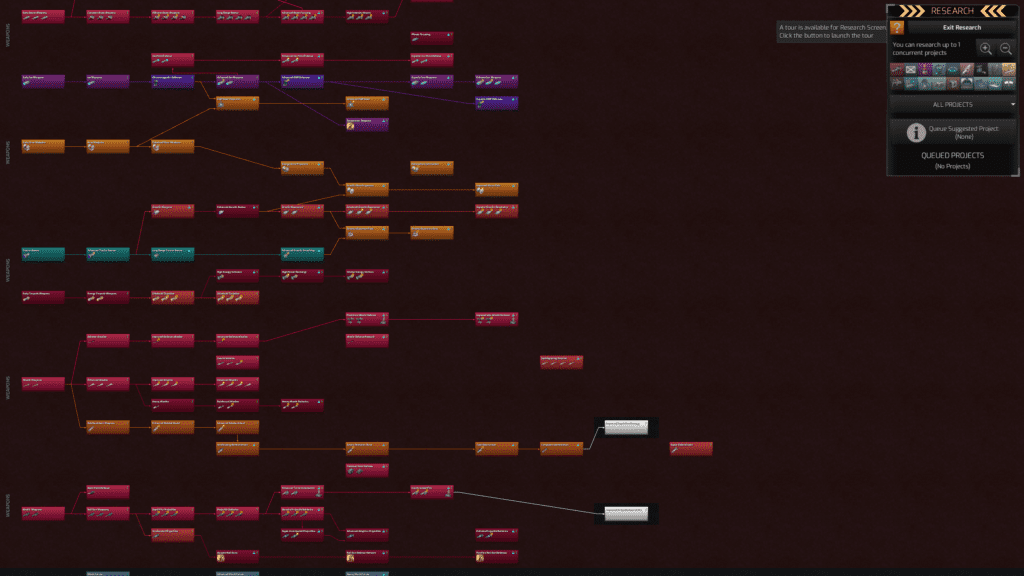
Distant Worlds 2 research tree in all its glory. One of the more satisfactory parts of the game
Graphics
4x strategy games rarely, if ever, win their audience over due to their unparalleled, next-gen visual effects. If anything, most of these games have attractive, yet mostly rudimentary visual displays. Distant Worlds 2 does not have impressive graphics, however, at times they are even underwhelming. A gas giant at times can look as if it was made in Windows Paint, just a green blob with not even a hint of pseudo-3D appearance. Hopefully, they will overhaul this part since right now the game gives off the impression that the graphic department still needed several months to finish everything up properly. Still, at the end of the day, this is not something I would personally take away points for when it comes to judging the quality of a 4x strategy game… But this could have been handled better, and I hope it will be revisited.
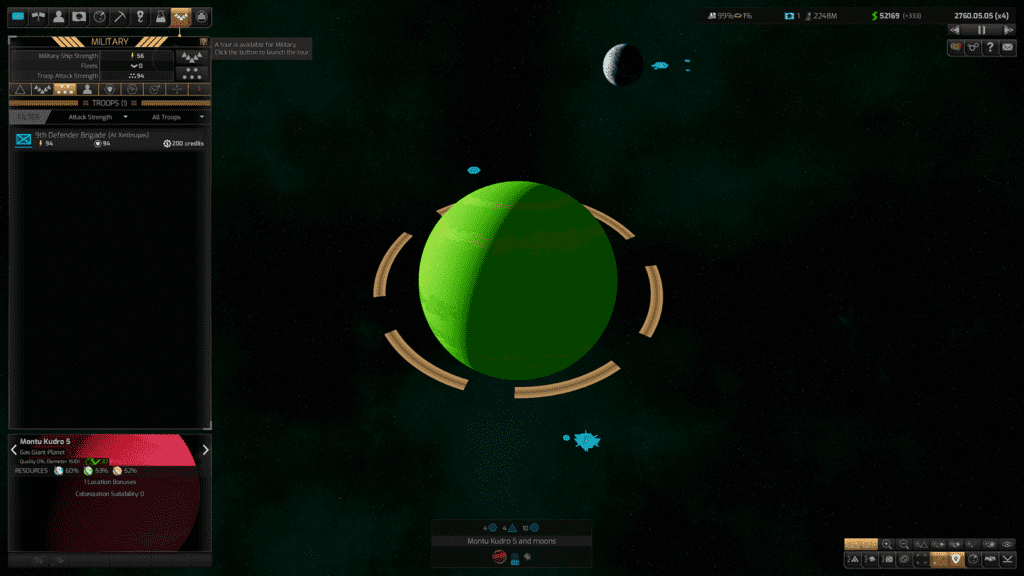
This green giant is crying for a makeover. Graphics are never the primary point of any 4X game, but this is just slacking…
Music
Sadly, I have nothing good to say about the Distant Worlds 2 soundtrack. It is irritating and disharmonious, it pulls attention to itself from gameplay, but in a negative way. The game makes an attempt to provide a dynamic score adaptation, meaning that the music switches to a more action-focused track before switching back to the monotone, yet strangely disharmonious main track. It disturbs you, it works against the atmosphere instead of generating it. It is odd to see this to be one of the major points of discontent, not just by me but also for a larger number of players as well. Distant Worlds: Universe has definitely had better music than the successor. Finally, I ended up turning off the music score entirely while playing, something I cannot recall having done in other games.
Espionage
My initial experience with spies was very positive, I must admit. Proper candidates kept appearing, were hired and would regularly bring different info back from their secret missions. By the latter end of the game, though, the enemy spies were wreaking havoc throughout my empire and were blowing up stations all over the place. Apparently, the devs have a weak spot for espionage where the spies can virtually blow up half of your mining stations in your galaxy. It seems that security is useless, so it is up to the 4-5 spies set to counterspy to keep you safe. At which they fail.
At times, your spies may even steal research, which is always a great bonus, but they can also be captured. The entire section of the game is rather rudimentary, and most of the time I would leave the management of espionage to the AI advisors.
Diplomacy: It’s all about money
Diplomacy is based solely on bribery, nothing more. If you run into an independent colony you would like to gobble up, send them gifts until they like you enough so you can invite them to join your empire. Essentially the same goes for pirate factions and other empires. Bribe them until you can annex them, that pretty much sums it up. Of course, you will be able to offer them trade agreements beforehand, but diplomacy overall feels as if it has been tacked on the game just to tick off a checkbox. Admittedly, it is hard to create a good, valid diplomacy system in this type of games, but Stellaris was doing a fairly decent job of it and Distant Worlds 2 could and should have copied that page from their book…
And now, to the… Not so good things about the game.
What is wrong with Distant Worlds 2?
Unfortunately, quite a lot. The game has solid foundations, but many areas can use significant improvement.
First of all, Distant Worlds 2 feels like early access, but it sells for a full triple AAA price. It should have stayed in development for another 3-6 months. There are a lot of bugs, crashes and technical difficulties tied to this title with great potential, and even though the devs made some patches to counter them, the damage may be done.
Performance at the endgame is, sadly, quite atrocious. Visuals turn into slideshows, no matter what beastly specc your PC brings to the fore. The game freezes, stutters, and crashes a lot in this phase.
Notification overload – once again, as the things get more heated during later parts of the game, you get overwhelmed by a flood notifications you cannot modify or filter. Once you have 60+ colonies and thousands of ships, getting the 276th notification that a random frigate of your has been attacked in sector 345fG6n can drive you insane.
Endgame becomes a chore, and even though it becomes rather clear in your campaign that you are going to win the game, you still need to spend 20 hours to sufficiently expand and reduce your enemies to rubble to gather that desired 75% of victory goals.

Endgame is very hard on the performance, no matter how beefed up your PC is…
Ship and base design is generally considered a step back when compared to the predecessors. Personally, I did not care a single bit about it, since I can’t be bothered to design new ships and bases every 10 minutes as I get upgrades through research, but old veterans of the series seem to be unanimous when it comes to this part.
Finally, the endgame forced me to give the control entirely to the AI. I just couldn’t do it anymore; it was obvious no other AI opponent can challenge my empire, and I could not handle the flood of tasks coming at me. I simply automatized everything, and left the game running on my computer for hours on several occasions. Sadly, AI advisors were not able to conquer enemy planets, simply throwing entire armies into the meat grinder, all the time having absolute supremacy over enemy space fleets, and capable of bombing enemy worlds back into stone age, or even turning them into dust clouds. Either way, the game should not make me feel feel exhausted to the point that I leave it running on its own, hoping it will be done by the time I return.
Oh, and the final victory? Just a random line on your screen saying “GAME OVER: Winner Terran”. This should stand in the dictionary for the description “anticlimactic”…
Final word
Distant Worlds 2 is huge game, rich in features, detail and options. I liked it a lot, but I didn’t love it. I think it requires more development time, and more investment to get where it deserves to be.
Distant Worlds 2 does not feel as a Stellaris killer, since these two games are sufficiently different to be able to co-exist. I would say however that is much deeper and broader in scope than Stellaris, offering much more features and options, yet it lacks the streamlining and optimization of Stellaris.
Overall, Distant Worlds 2 is a good game, with the potential to become a truly great 4x space strategy game. There is a very solid core to it, one I hope the developers will continue building upon. If they stick with it, well, the sky is the limit.
